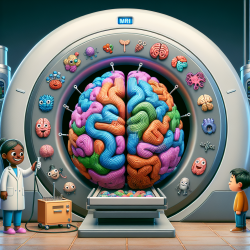Understanding Developmental Language Disorder (DLD)
Developmental Language Disorder (DLD) affects approximately 7% of children, presenting challenges in learning their native language without an obvious cause. These difficulties can lead to academic struggles, social challenges, and future employment issues. Recent research utilizing quantitative MRI techniques has begun to unravel the neural underpinnings of DLD, offering new insights that could revolutionize therapeutic approaches.
The Breakthrough: Quantitative MRI and Myelin Mapping
A groundbreaking study by Krishnan et al. (2022) employed a novel MRI technique known as multi-parameter mapping (MPM) to investigate the brain microstructure of children with DLD. This method allows for the detailed mapping of myelin, a crucial component for efficient neural communication, in various brain regions.
The study revealed that children with DLD have reduced myelin in key areas of the brain associated with language processing, such as the caudate nucleus and the left ventral sensorimotor cortex. These findings suggest that myelin deficits in these regions may contribute to the language difficulties experienced by children with DLD.
Implications for Speech-Language Pathologists
For practitioners, these findings underscore the importance of considering neural microstructure when developing intervention strategies. Here are some practical steps to incorporate these insights into therapy:
- Targeted Interventions: Focus on exercises that enhance myelin development through repetitive practice and stimulation of affected brain regions.
- Neuroplasticity: Leverage the brain's ability to reorganize and form new connections by incorporating activities that promote sequential learning and habit formation.
- Continuous Monitoring: Use quantitative MRI as a tool to monitor progress and adjust therapeutic strategies based on changes in brain microstructure.
Encouraging Further Research
While this study provides valuable insights, it also highlights the need for further research to fully understand the causal relationships between myelin deficits and language difficulties. Future studies could explore:
- The potential for interventions to enhance myelin development in children with DLD.
- The role of genetic factors in myelin development and DLD.
- Longitudinal studies to track changes in myelin and language abilities over time.
Conclusion
The application of quantitative MRI in understanding DLD opens new avenues for effective intervention strategies. By focusing on the neural basis of language disorders, practitioners can tailor their approaches to better meet the needs of children with DLD, ultimately improving their language outcomes and quality of life.
To read the original research paper, please follow this link: Quantitative MRI reveals differences in striatal myelin in children with DLD.










